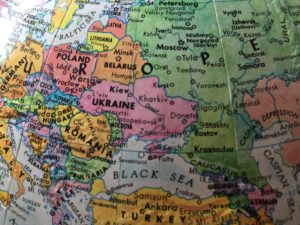Seizing Russian State Assets to Rebuild Ukraine: Will it Prolong the War, or End it?
In this excerpt from The Conversation, Jon Unruh, a Professor at McGill University, and Geoffrey Goodell, a Lecturer in Financial Computing at UCL, discuss the bill Senator Omidvar tabled to seize Russian state assets in order to pay for rebuilding Ukraine:

Sanctions and leverage
Current tools used to try to halt a warring state’s actions —sanctions, embargoes, asset freezes and international exclusion, for example — are designed to be reversible so as to create leverage. The message, essentially, is this: stop the war, and you’ll get your trade, assets and access back.
While less than effective much of the time (which explains the ongoing nature of many sanctions against Russia), this is nonetheless the favoured logic of the international community.
The current war in Ukraine is causing a reconsideration of this logic. With sanctions on Russia clearly not working — Russian officials seem to be assuming they’ll get their trade, assets and access back — the prolonged war is increasing the cost of reconstruction enormously.
Western taxpayers are not keen to foot the bill for this, especially when the value of Russian state assets frozen by the West is so large.
The obvious alternative is to simply use the frozen Russian money instead of hard-earned western taxpayer funds to rebuild Ukraine. It’s an attractive logic, but has been criticized for being non-reversible, thereby depriving the West of a way to pressure Russia to end the war.
Certain western countries are concerned about this. But Canada draws a different conclusion.
Different types of leverage
Canadian Sen. Ratna Omidvar successfully pushed for the modification of SEMA to allow for the seizure of an aggressor state’s assets for use in reconstructing countries it invades.
While other states are keen to follow, the concern about a loss of leverage persists. However, the way seizure happens can mean the difference between losing leverage and creating leverage — and the possible birth of a new tool.
Leverage in international relations is a curious thing. There is “reward leverage,” when states are rewarded for complying with international norms. Unfreezing assets falls into this category.
Then there is “threat leverage,” with the threat of progressively punishing countermeasures that can be put in place for non-compliance. There’s also “reversible rewards” that combine the two approaches.
While seizing Russian state assets may lessen the reward leverage associated with unfreezing assets, it can also, if done right, create significant threat leverage.
If the seizure of assets is explicitly and publicly linked to specific belligerent actions — like targeting civilians, refusing to return abducted children, destroying civilian infrastructure or failing to de-escalate — then the phased seizure becomes a tool that acts as a threat against further belligerent actions. It’s linked to specific asset seizures in the future.
The phased confiscation of assets therefore has three purposes: it serves as progressive punishment, as money used to rebuild and as leverage against a state for further harms.
Read the full article in The Conversation